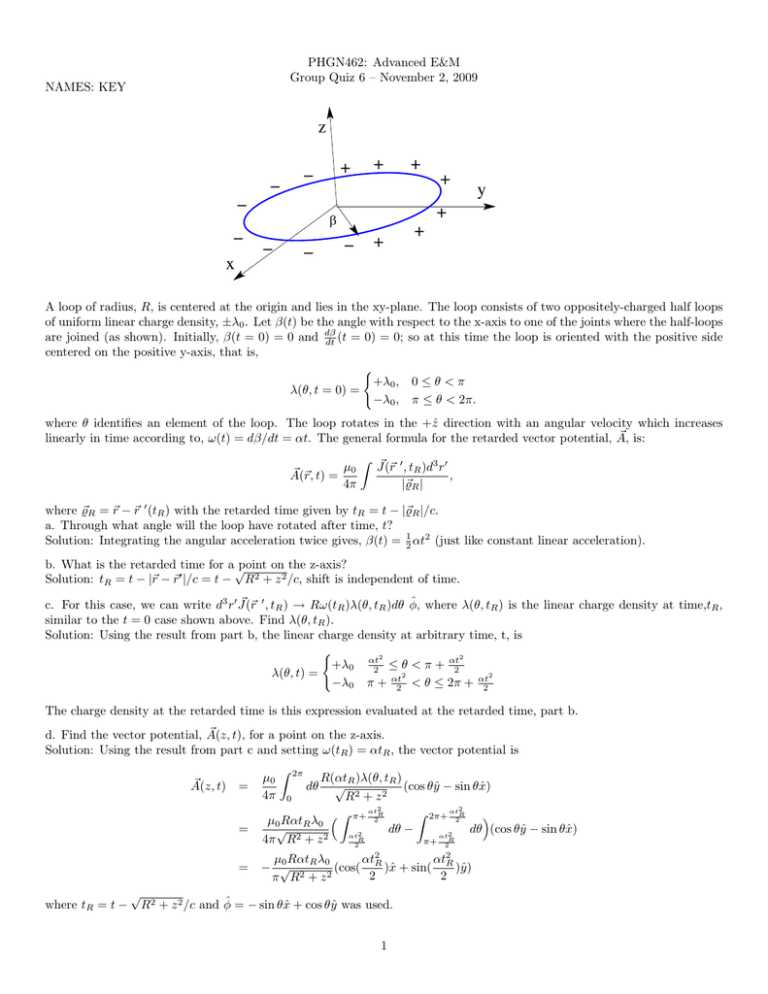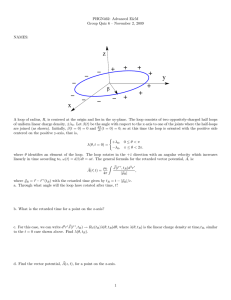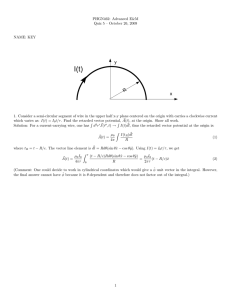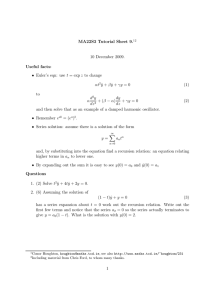z + − y
advertisement

PHGN462: Advanced E&M Group Quiz 6 – November 2, 2009 NAMES: KEY z − − − x + − + + − y + β − + − + + A loop of radius, R, is centered at the origin and lies in the xy-plane. The loop consists of two oppositely-charged half loops of uniform linear charge density, ±λ0 . Let β(t) be the angle with respect to the x-axis to one of the joints where the half-loops are joined (as shown). Initially, β(t = 0) = 0 and dβ dt (t = 0) = 0; so at this time the loop is oriented with the positive side centered on the positive y-axis, that is, ( +λ0 , 0 ≤ θ < π λ(θ, t = 0) = −λ0 , π ≤ θ < 2π. where θ identifies an element of the loop. The loop rotates in the +ẑ direction with an angular velocity which increases ~ is: linearly in time according to, ω(t) = dβ/dt = αt. The general formula for the retarded vector potential, A, ~ r, t) = µ0 A(~ 4π Z ~ 0 J(~r , tR )d3 r0 , |~ %R | where % ~R = ~r − ~r 0 (tR ) with the retarded time given by tR = t − |~ %R |/c. a. Through what angle will the loop have rotated after time, t? Solution: Integrating the angular acceleration twice gives, β(t) = 21 αt2 (just like constant linear acceleration). b. What is the retarded time for a√ point on the z-axis? Solution: tR = t − |~r − ~r0 |/c = t − R2 + z 2 /c, shift is independent of time. ~ r 0 , tR ) → Rω(tR )λ(θ, tR )dθ φ̂, where λ(θ, tR ) is the linear charge density at time,tR , c. For this case, we can write d3 r0 J(~ similar to the t = 0 case shown above. Find λ(θ, tR ). Solution: Using the result from part b, the linear charge density at arbitrary time, t, is ( 2 2 +λ0 αt2 ≤ θ < π + αt2 λ(θ, t) = 2 2 −λ0 π + αt2 < θ ≤ 2π + αt2 The charge density at the retarded time is this expression evaluated at the retarded time, part b. ~ t), for a point on the z-axis. d. Find the vector potential, A(z, Solution: Using the result from part c and setting ω(tR ) = αtR , the vector potential is ~ t) A(z, = = Z 2π R(αtR )λ(θ, tR ) √ (cos θŷ − sin θx̂) R2 + z 2 0 αt2 Z Z 2π+ αt22R R µ0 RαtR λ0 π+ 2 √ dθ − dθ (cos θŷ − sin θx̂) αt2 αt2 R 4π R2 + z 2 π+ 2R 2 µ0 4π dθ µ0 RαtR λ0 αt2 αt2 = − √ (cos( R )x̂ + sin( R )ŷ) 2 2 2 2 π R +z where tR = t − √ R2 + z 2 /c and φ̂ = − sin θx̂ + cos θŷ was used. 1






